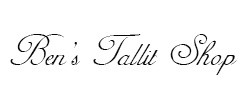We get about a dozen inquiries a week with tallit, tallit sizing and tallit atara questions. That adds up to a whole lot of tallit and tzitzit questions over the years. Since you may be wondering some of the same things, we compiled two dozen questions and wrote brief answers.
Tallit Questions
What type of tallit should I buy?
The simple answer is you should buy a wool tallit. Wool looks nice, lasts for many years, is preferable from a halachic standpoint, and has been the tallit fabric of choice for generations.
Where can I buy a tallit?
That's easy enough: on our webstore! Scroll up this page and click on the store logo on the upper left.
How much does a tallit cost?
Tallit prices vary from $20 to about $500. No kidding. But in general you can expect to pay $60-$120 for a standard wool tallit. The price depends on size, fabric and features. A very standard wool tallit in a medium size (size 60) should run you about $80-$100 plus shipping. We sell it for $75 because we're a family-run business. Go to Classic Tallit category
What does it say on the atarah?
The atara, or tallit neckband, doesn't have to say anything. Sometimes is will have a very quiet leaf design and no words, or colorful striping. But it has become very popular to have the Tzitzit Blessing embroidered on the atara. The Tzitzit Blessing is the brachah you recite when you put on a tallis.
Is a 24" x 70" tallit a medium size tallit?
A size 24 tallit is 24 inches wide and 70 or 72 inches long. It is designed to sit on the neck and hang down in front, not covering the back, the way a tallit is traditionally worn. A size 24 tallit is sort of one-size-fits-all. It's designed to fit a 5' bar mitzvah boy and a 6' man alike. Tallit manufacturers do not make different lengths, which I always found a bit surprising. If you need a tallit for a short bar mitzvah boy, contact us for options. If you go with a handwoven tallit and are ordering at least two months in advance, there should be no problem at all getting exactly the dimensions you need.
Can a tallit and its tzitzit be shatnez?
Shatnez is a fabric mixture of wool and linen forbidden by the Torah. Any other fabric combination (including wool and cotton) is fine. Putting linen tzitzit on a wool tallit or wool tzitzit on a linen tallit is forbidden by the Torah. Because of this issue, the custom today is not to use linen, either for the tallit or the tzitzit. Certain exceptions may apply. If the question is germane to you (e.g. you have a severe wool allergy), consult with a qualified rabbi.
Is a silk linen blend kosher?
Yes. See previous question.
Can I use a tallit at night?
Yes, but you cannot recite a bracha on it. Some Yemenite Jews have a custom of wearing a tallit on Shabbos night and wearing a tallit on the night of Yom Kippur is a nearly universal custom.
Can single men wear a tallit?
According to the widespread Ashkenazi custom, single men do not wear a tallit. Sephardic, Yemenite and German Jews do wear a tallit before they are married.
Will a cotton tallit wrinkle?
Some handwoven tallits are made of cotton. Yes, they can develop slight wrinkles. But handwoven tallit makers us a very thick type of cotton yarn, so you see very little creases.
Does the groom wear a tallit during a Jewish wedding?
Many Ashkenazi men do not wear a tallit until they are married (see above). Likewise, generally the Ashkenazi custom is not to wear a tallit during the wedding, although there are many exceptions. There is also a custom for the bride (or her parents) to buy a tallit for the groom before the wedding.
Who buys the tallis for a bar mitzvah?
This is one of my favorite questions, but I'm not sure how to answer it. Since wearing a tallis with tzitzis is a mitzvah, I would say the bar mitzvah boy should buy himself a tallis. However, that sounds very unrealistic among 99% of bar mitzvah boys today. Generally the parents will buy the tallis for the bar mitzvah. We also get a lot of grandparents buying a tallis for their grandson.
Is it ok to iron a tallit?
Yes, you can iron your tallit, but don't expect great results. Most tallits are made of wool, and wool is not easy to iron.
Where can I find an artistic, handmade blue and white tallit blue and white tallit?
The handwoven tallit makers we work with offer a number of attractive blue-striped designs on a white base.
What is the meaning of "bnei ohr?"
The "Bnei Ohr" (alternative spellings include Bnai Ohr, Bnei Or, Bney Ohr, etc.) tallit employs a popular rainbow design. Bnei ohr is Hebrew for "Children of Light."
Should I personalize the tallit bag?
I think custom letter embroidery on a tallit bag is a very nice addition, whether you are buying a tallit bag for yourself, a bar mitzvah boy, a groom or your husband. Our fee for letter embroidery is $1 per letter in Hebrew or English. That means just putting on initials or a short name is very affordable, whereas a long name (e.g. Yaakov Yisrael ben Menachem Mendel or Yerachmiel Chaim Schwartzkoff) can start getting expensive.
What is the name of the bag for a tallis?
That's easy enough. A tallit bag (or tallis bag).
 United States Dollar
United States Dollar
 Shekel
Shekel
 Euro
Euro
 British Pound
British Pound
 Australian Dollar
Australian Dollar
 New Zealand Dollar
New Zealand Dollar
 Canadian Dollar
Canadian Dollar
